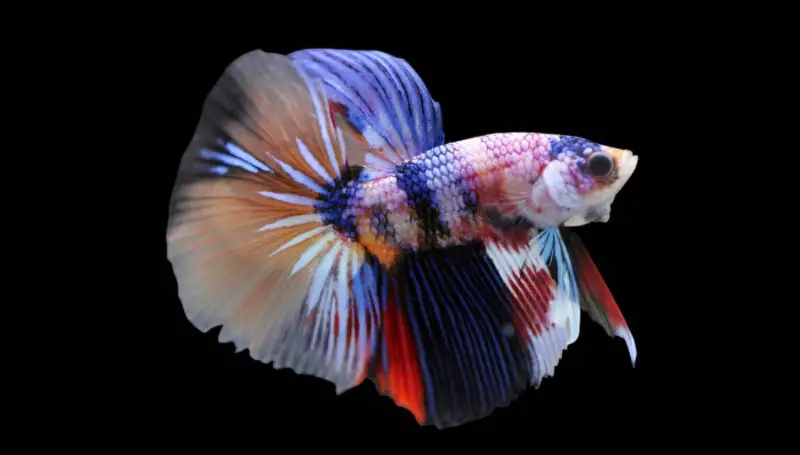Spotting the difference between male and female betta fish can be easy or it can be difficult. This is because if you don’t know what to look for, it’s difficult. While, if you do know what to look for, it’s a total breeze!
When I first got into the hobby over 30 years ago, I would check out fish stores and see that all the males seemed to have long fins, whereas, all the females had short fins. So, I thought I had it all figured out. That was until I saw a relatively short finned male betta and I realized I had to go home and do some research!
What Exactly Is A Betta Fish?
First of all, we need to clear up exactly what kind of fish we’re talking about. “Betta fish” as they’re commonly known are actually just one species—Betta splendens—of an entire genus. So far, over 70 distinctly different species have been described in the betta genus!
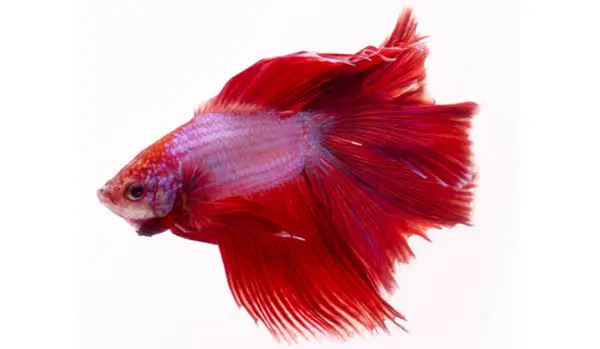
But, for this article, we’re simply talking about one of those species: B. splendens. In some countries, this fish is also known as the “Siamese fighting fish”.
Wild Betta Splendens Vs. Domesticated Betta Splendens
At this point we know exactly what we’re talking about when we say “betta” right? Not exactly, because there’s another division we need to be aware of: wild B. splendens and domesticated B. splendens are quite different. These differences came about as a result of selective breeding for particular appearances.
In this article I want to focus on the domestic types because that is what you will almost encounter in the hobby.
What Is Sexual Dimorphism
Simply put, sexual dimorphism is the difference between males and females in the same species.
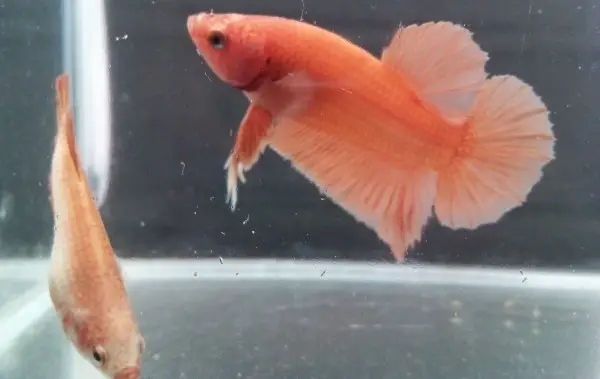
A male and female betta splendens. Can you spot the difference?
Let’s break the term down.
Firstly, “sexual”—well, that’s simple enough, it means relating to the sexes, i.e. males and females. “Dimorphism” can be broken down into “di” and “morph”. First of all, “di” simply translates to “two” from Greek.
Whereas, “morph” is a more interesting word. If we take the general definition, it means to change from one form to another. However, in biology, “morph” has a different meaning. In the context of an animal, a different type found within a single species is known as a different morph. For example, as fishkeepers, we’ve probably all heard somebody say “it’s a different color morph”.
So that should explain it. Sexual dimorphism is the degree to which the male and female are different. We say that an animal has “strong” sexual dimorphism or “weak” sexual dimorphism.
Good examples in the fish world are oscar cichlids and swordtails. First of all, with oscars, the male and female are notoriously difficult to tell apart. Whereas, with swordtails, the male is patently obvious because of the long sword shape it develops on its caudal fin.
So, back to bettas: how different are the males compared to the females?
Differences In Coloration Between Male & Female Bettas
Domesticated bettas do not display significant color differences between males and females. In fact, I’d say it’s non-existent. Because, any color you can find in a male betta, you can find a female betta with the same type of coloration!
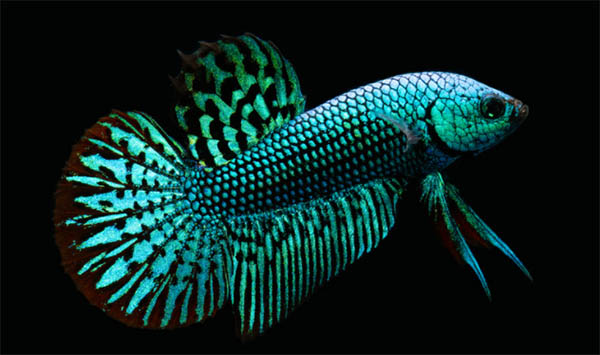
However, in the wild type B. splendens the male is generally more colorful. Whereas, the female tends to have a more prominent horizontal stripe along her flank.
Male & Female Bettas Have Different Body Shapes
This is a good place to start when you want to sex a betta. Because once you familiarize yourself with their different body shapes you’ll be able to tell the difference between a male betta and a female betta more easily.
In short, females are recognizable because, especially when mature, as much plumper looking than their slender, male counterparts. The best place to spot the thickness of the female versus the male is head on; females look quite oval, whereas males almost look triangular, with the point of the triangle at the top of their body.
Differences In Fins: All Short Finned Bettas Female? No!
As I mentioned in the introduction, I thought as a child that long fins = male and short fins = female. It was only later that I began to realize that the wild male betta has “short fins” also.
I put short fins in quotes because the wild male actually does have slightly longer fins than the female. But, it’s nowhere near as dramatic as in the long finned domestic varieties.

But, in short finned domestic strains, you can use fin length and shape to tell a male betta apart from a female betta. In particular, the male has thicker and longer pelvic fins. Whereas, the female betta’s equivalent fins are thin and short. In addition, the male’s anal fin is extended, while the female’s is short and neat.
Females: Check For An Ovipositor
Now we come to—as far as I’m concerned, anyway—the absolute easiest way to tell whether a betta fish is male or female: the ovipositor.
If you’re relatively new to fishkeeping, you might be wondering, “what the heck is an ovipositor?!” Well, it’s the organ that female fish use to lay eggs.
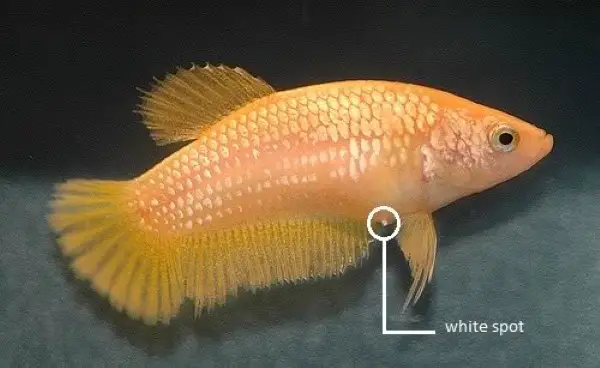
In some fish, like cichlids, the females keep them retracted until they are ready to lay eggs soon. However, fortunately for us, female bettas are different and their ovipositor is always visible once they are sexually mature.
To find your betta’s ovipositor, look at her underside. If the fish really is a female, you’ll see a small, white spot positioned after the pelvic fins but before the anal fin.

It’s very small, so you might need an old fashioned magnifying glass or maybe the zoom on your phone to really see it!
Behavior: Gill Flaring
It’s a common misconception that only the male betta flares its gills, the females will also spread open their gill plates as a display of strength.
However, there are differences. The male’s gill flaring is more impressive because of a “beard” it has behind its gill plates. This makeshift beard flares out beyond the gill plates, causing the fish to look extra intimidating.
Behavior: Bubble Nest Buildding
Generally, only the male builds a bubble nest.
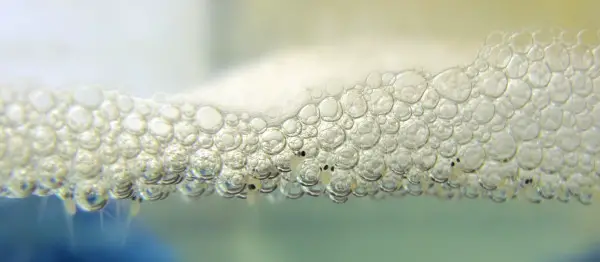
https://commons.wikimedia.org/w/index.php?curid=7395701
Generally only the male betta builds a bubble nest.
So, if your betta has short fins but it is building a bubble nest, it’s probably a female. While I haven’t witnessed it personally, some people do report that their female bettas have blown bubble nests. I suppose anything’s possible!
Conclusion
In conclusion, there are several ways you can tell a male betta and female betta apart. Using a combination of the differences discussed in this article you should be able to tell them apart quite easily.
To summarize:
- Male bettas (even the short fin varieties) have slightly longer anal fins and broader pelvic fins.
- Females bettas have a thick and oval shaped body. Whereas, males are more triangular in shape, with the peak of the triangle at the top of their body.
- Males bettas have a “beard” and it can be seen when they flare their gills. Female bettas do not have a frilly “beard” extension to their gills.
- Male bettas build bubble nests, but female bettas do not.
- In wild bettas, males are slightly more colorful than females.
- Female bettas have an ovipositor. Fish use the ovipositor to lay eggs; it looks like a small white spot between the pelvic and anal fins.
Recommended Products

- Buy Live Plants For Your Betta Tank Online!
- Best Food To Feed Your Fish!
- Fluval Plant 3.0 vs Finnex Planted+ 24/7

